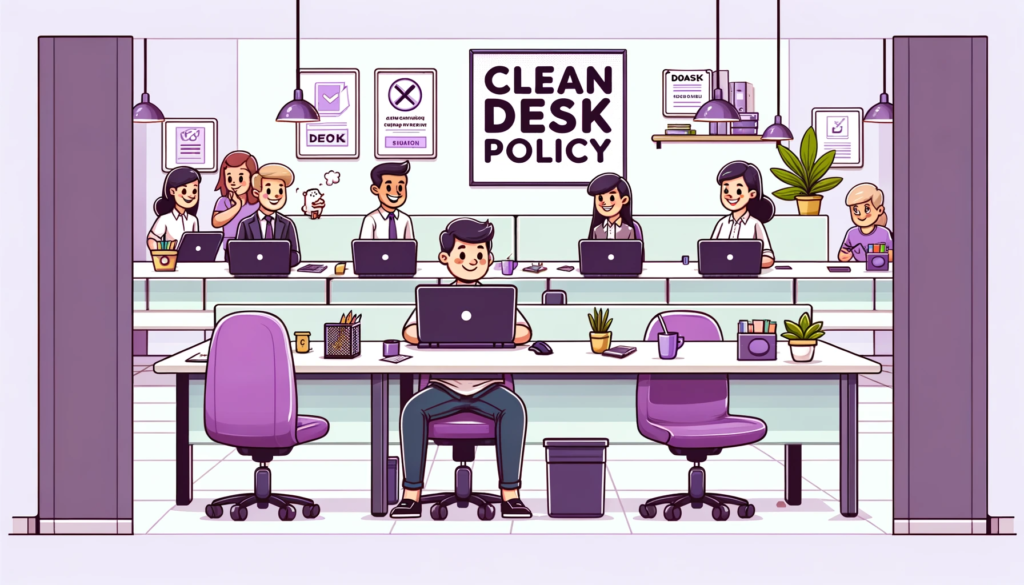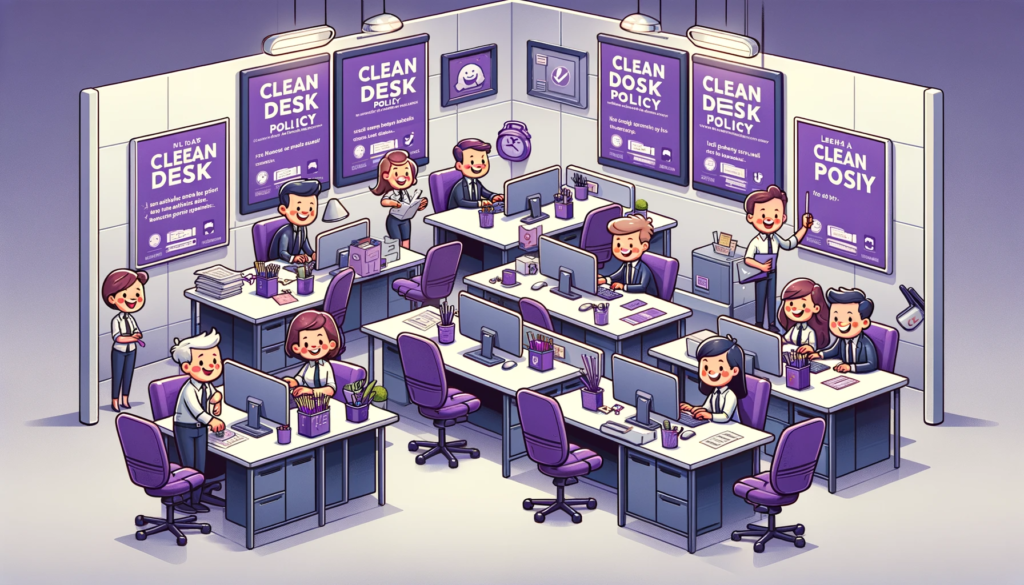Purpose of Clean Desk Policy
A clean desk policy is a set of guidelines that requires employees to keep their workspaces free of clutter and confidential information. The main purpose of a clean desk policy is to ensure that sensitive information is not left out in the open where it can be seen or accessed by unauthorized personnel.
By implementing a clean desk policy, organizations can protect their confidential data from theft, loss, or damage. This policy also helps maintain a professional work environment and promotes productivity and efficiency.
In addition, a clean desk policy can help organizations comply with legal and regulatory requirements, such as the General Data Protection Regulation (GDPR) and the Health Insurance Portability and Accountability Act (HIPAA). These regulations require organizations to protect personal and sensitive information from unauthorized access or disclosure.
To ensure that the clean desk policy is effective, organizations should provide training and awareness programs to their employees. They should also enforce the policy consistently and regularly monitor compliance.
Scope and Applicability
Employees Covered
The Clean Desk Policy applies to all employees of the company, regardless of their position or department. This includes full-time, part-time, and contract employees. It is the responsibility of each employee to comply with the policy and maintain a clean and organized workspace.
Areas Enforced
The policy is enforced in all areas of the workplace, including individual workstations, conference rooms, and common areas such as break rooms and copy rooms. All employees are expected to keep their work area clean and free of clutter at all times. This includes removing any unnecessary papers, materials, or personal items from their desk.
The Clean Desk Policy is an important part of maintaining a professional and organized workplace. By keeping workspaces clean and clutter-free, employees can increase their productivity and reduce the risk of losing important documents or confidential information. The policy helps to promote a culture of responsibility and accountability among employees, which is essential for the success of any organization.
Policy Requirements
The Clean Desk Policy requires that all employees keep their work areas clean and organized. This policy helps ensure that sensitive information is not left out in the open where it could be accessed by unauthorized individuals.
Document Handling
All physical documents should be properly labeled and stored in locked cabinets or drawers when not in use. Employees should also shred any documents that are no longer needed and dispose of them in a secure manner.

Digital Security
Employees must ensure that all digital files are stored securely on the company’s network and not on personal devices or cloud storage. Passwords should be used to protect sensitive files, and employees should log out of their devices when they are not in use.
Physical Security
Employees must ensure that their work areas are kept secure at all times. This includes locking their computers when they step away from their desks and not leaving sensitive documents or devices out in the open.
By following these policy requirements, employees can help maintain a secure work environment and protect sensitive information from unauthorized access.
Responsibilities
Employee Duties
Employees play a crucial role in maintaining a clean desk policy. They are responsible for keeping their work area tidy and organized. This includes disposing of any unnecessary papers or items, storing important documents in designated areas, and wiping down surfaces regularly. Employees should also ensure that their computer desktop is kept clean and free of clutter.
In addition, employees should report any maintenance issues or equipment malfunctions that could lead to a messy work environment. They should also be aware of any confidential or sensitive information that may be on their desk and take necessary precautions to keep it secure.
Management Duties
Management is responsible for enforcing the clean desk policy and ensuring that all employees are following it. This includes providing training and resources to employees on how to maintain a clean and organized workspace.
Management should also regularly inspect workstations to ensure that they are in compliance with the policy. If an employee is found to be in violation of the policy, management should provide feedback and guidance on how to improve.
It is also the responsibility of management to lead by example and maintain a clean and organized workspace themselves. This sets a positive tone for the rest of the team and reinforces the importance of the policy.
Compliance Measures
Monitoring Procedures
To ensure compliance with the clean desk policy, regular monitoring procedures are implemented. This includes periodic inspections by managers and designated personnel to check that employees are adhering to the policy. The monitoring process involves visually inspecting workstations, filing cabinets, and storage areas to ensure that they are free of clutter and confidential information is properly secured.
Additionally, the use of technology such as security cameras and computer software is implemented to monitor and track employee activity. This enables management to identify any violations of the clean desk policy and take appropriate action.
Disciplinary Actions
Failure to comply with the clean desk policy can result in disciplinary actions. These actions can range from verbal warnings to written reprimands and even termination of employment in severe cases. The disciplinary actions are designed to reinforce the importance of the policy and ensure that all employees are aware of the consequences of non-compliance.
In addition to disciplinary actions, training and education programs are implemented to ensure that employees understand the policy and the reasons behind it. This helps to promote a culture of compliance and ensures that all employees are aware of their responsibilities in maintaining a clean and secure workspace.
Overall, the compliance measures in place help to ensure that the clean desk policy is followed and that confidential information is properly secured. This promotes a safe and secure work environment and helps to protect the interests of the organization and its clients.
Policy Review and Modification
As with any policy, it is important to periodically review and modify the Clean Desk Policy to ensure its effectiveness. This section will outline the steps involved in reviewing and modifying the policy.
Firstly, the policy should be reviewed on a regular basis, such as annually or bi-annually. During this review, feedback from employees should be gathered to identify any areas of the policy that may need to be modified. This feedback can be collected through surveys, focus groups, or one-on-one meetings with employees.
Once feedback has been gathered, the policy should be modified to reflect any necessary changes. This may include updating the policy language to ensure clarity, modifying specific procedures, or adding new requirements to the policy.

It is important to communicate any changes to the policy to all employees in a clear and concise manner. This can be done through email, company-wide meetings, or other communication channels. Additionally, employees should be provided with training on any new procedures or requirements.
Finally, the modified policy should be re-evaluated periodically to ensure its continued effectiveness. This may involve gathering feedback from employees or conducting audits to ensure compliance with the policy.
Overall, regular policy review and modification is essential to ensure the Clean Desk Policy remains effective in promoting a clean and organized work environment.
Exceptions and Exemptions
While a clean desk policy is an effective way to promote a safe and organized work environment, there are certain situations where exceptions and exemptions may be necessary.
One common exception is when an employee is actively working on a project and needs to have materials readily available. In this case, it may be acceptable to have a few items on the desk as long as they are directly related to the task at hand. However, once the project is completed, the employee should return the materials to their designated storage location.
Another exception is for employees with disabilities or medical conditions that require them to have certain items on their desk, such as medication or assistive technology. In these cases, accommodations should be made to ensure that the employee can perform their job duties safely and effectively.
It is important to note that exemptions should be granted on a case-by-case basis and not used as an excuse to maintain a cluttered workspace. Employers should communicate the policy clearly and provide training on how to maintain a clean desk while still being productive.
By allowing for reasonable exceptions and exemptions, employers can promote a culture of flexibility and inclusivity while still maintaining a safe and organized work environment.
Training and Awareness
To ensure the successful implementation of a clean desk policy, proper training and awareness programs must be put in place. This will help employees understand the importance of maintaining a clean and organized workspace and the impact it has on the overall productivity of the organization.
The training program should cover the following areas:
Policy Overview
Employees should be provided with a clear and concise overview of the clean desk policy. This should include the purpose of the policy, the benefits of maintaining a clean workspace, and the consequences of failing to comply with the policy.
Best Practices
The training should also cover best practices for maintaining a clean and organized workspace. This could include tips on how to organize documents and files, how to properly store office supplies, and how to keep the desk free from clutter.
Implementation
To ensure that the policy is effectively implemented, employees should be provided with the necessary tools and resources. This could include storage solutions, labeling systems, and guidelines on how to properly dispose of confidential documents.
Awareness Campaigns
To reinforce the importance of the clean desk policy, awareness campaigns should be conducted regularly. This could include posters and flyers reminding employees to keep their workspace clean, email reminders, and team meetings to discuss the policy.
By providing proper training and awareness programs, employees will be more likely to understand the importance of maintaining a clean workspace and will be motivated to comply with the policy. This will ultimately lead to a more productive and efficient work environment.
Related Policies and References
A clean desk policy is often implemented as part of a larger set of policies that aim to improve security, productivity, and organization in the workplace. Here are some related policies and references that may be useful to consider:
- Information Security Policy: This policy outlines the measures that an organization takes to protect its sensitive information from unauthorized access, disclosure, and destruction. A clean desk policy is often a component of an information security policy, as it helps to prevent sensitive information from being left out in the open where it can be easily seen or stolen.
- Data Retention Policy: This policy specifies how long an organization must keep certain types of data, and when it can be safely disposed of. A clean desk policy can help to ensure that sensitive data is properly stored and secured during its retention period, and that it is disposed of in a timely and secure manner when it is no longer needed.
- Office Layout and Design Guidelines: The layout and design of an office can have a significant impact on productivity, collaboration, and employee satisfaction. A clean desk policy is often easier to implement in an office that has been designed with organization and cleanliness in mind.
- Employee Handbook: An employee handbook is a comprehensive guide to an organization’s policies, procedures, and expectations. A clean desk policy should be clearly outlined in the employee handbook, along with any consequences for non-compliance.
- ISO 27001: ISO 27001 is an international standard for information security management systems. It provides a framework for organizations to manage and protect their sensitive information. A clean desk policy can help to demonstrate compliance with ISO 27001, as it is one of the recommended security measures.
A clean desk policy is just one of many policies and practices that can help to improve security, productivity, and organization in the workplace. By implementing a comprehensive set of policies and procedures, organizations can create a culture of security and efficiency that benefits both employees and customers.

